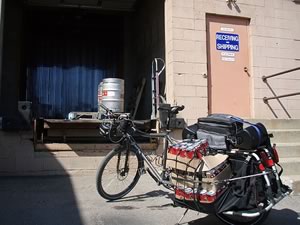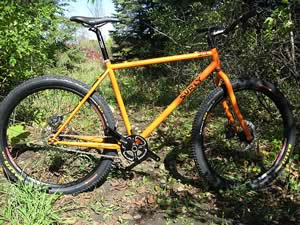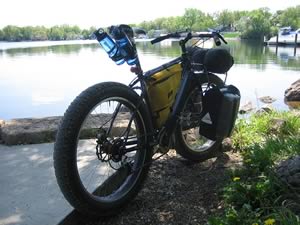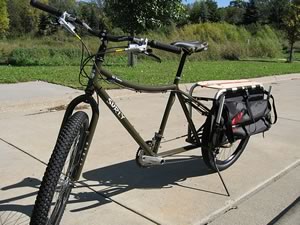Surly Bicycles: the Andy Corson Interview
I love bicycles. When I was growing up in Venezuela in the 80’s my brother and I spent a lot of time on our bikes. He and our cousin Manuel would add 5 speed cassettes with top tube t-shifters to our BMX bikes. I reckon we were sorta making our own mountain bikes before we knew what they were.  I moved to the States as a teenager and spent the next few years riding BMX when I wasn’t on my skateboard. Bicycles have always been a really fun part of my daily life and over time I’ve learned that most times with bikes simpler is better.
I moved to the States as a teenager and spent the next few years riding BMX when I wasn’t on my skateboard. Bicycles have always been a really fun part of my daily life and over time I’ve learned that most times with bikes simpler is better.
I decided to interview the boys at Surly for a few reasons. First off I love their bikes and love to sing their praises. Secondly, I think there’s a lot to learn from Surly in terms of good old American pragmatic thinking and DIY ethics. Surly as a company is not focused on being swayed by the trends or even marketing to trendsetters and hipsters. They build a few frames for different types of purposes and they use quality materials and workmanship. Surly makes no claims that they cannot back up. They make bicycles and they ride them. Enjoy.
Q. How long has Surly been around and how did the company come about?
A: Surly started in the mid-to late 90s as a single speed company. The bike-as-life scene in Minneapolis then was smaller compared to now but it was fertile and active and electric. Riders here and in other places had begun converting their geared mountain bikes to single speeds, at least in part in answer to what was viewed as a cancerous rise of technology for the sake of technology in bicycles. So it was this ideology delivered in a ‘new’ discipline, addictive for its refreshing challenge, its party on! gusto and its charismatic main characters. And everybody was a main character.
Single speed drivetrains have somewhat different design requirements than multi-geared systems, and at the time decent single speed-specific stuff wasn’t really available. However some of the riders worked for Quality Bicycle Products, a big bike parts distribution company about 20 miles south of Minneapolis. Several employees had made prototypes on their own of devices to take the chain slack out of a single ring and cog drivetrain. Wakeman Massie, who had been hired by QBP to design parts for their lines of fill-in accessories, convinced them to manufacture and sell some. These were sold as the 1X1 Singleator2000. That was in 1998. The next year Wakeman and Josh Yablon, another former QBP engineer, designed and sourced production for an adult sized single speed specific mountain bike frame, which was sold as the 1X1 Rat Ride. We still offer that frame, slightly modified, as the Surly 1X1.
By the next year, QBP had been convinced to give it a try as its own off-shoot brand. Wakeman was in charge. He hired Dave Gray and Hurl Everstone (of Cars-R-Coffins fame). These three really gave it the foundation for what it would become, and they had an unofficial staff in the single speeders of the MPLS riding community to give the thing shape and legitimacy. They brought in a few more parts and the Cross Check, first as a frame and then as a complete bike, and the Pacer road frame.
Wakeman and Hurl left after a year and a half and Dave found himself in charge of the thing and hired me and Nick Sande, in 2001 I think. The three of us ran it by ourselves for quite a few years. And here we are now, turning 11 this year and we have 9 official employees we have kids and houses and we’re globally delicious.
Q. You guys have been promoting simple and long-lasting bike transportation for a long time. Product lifespan is one of the corner stones of sustainability and this is sometimes a point of contention in surfboard manufacturing. What is Surly’s stance on building products with a long life span? Is there an ethical reason behind it?
A: We’ve never worried that our stuff is too durable. Part of the reason Surly came about was because single speeds are more durable systems than derailleured bicycle drive trains. That was and is still appealing to many people. If you like to ride bikes a Surly is a good balance of responsive design and durability.
 As for ethics, all I can say is lighter is not always better, more ‘speeds’ isn’t necessarily what everyone is looking for in a bike, and kids in the rural plains generally are not going to benefit from 6” of suspension travel. But that is how a lot of stuff has for years been marketed. A lot of offerings on bike shops sales floors remain trickle-down race technologies that are ill-suited to commuting, riding to school, picking stuff up from the store, and many other things people use bikes for.
As for ethics, all I can say is lighter is not always better, more ‘speeds’ isn’t necessarily what everyone is looking for in a bike, and kids in the rural plains generally are not going to benefit from 6” of suspension travel. But that is how a lot of stuff has for years been marketed. A lot of offerings on bike shops sales floors remain trickle-down race technologies that are ill-suited to commuting, riding to school, picking stuff up from the store, and many other things people use bikes for.
If we can produce stuff that exceeds people’s expectations, both in terms of value and ride quality, that speaks well of us. The greatest compliments we receive are from people who write in to tell us how much they enjoy riding their Surly, and how tough it has proven to be, and how because of all that they are buying another Surly. Their first one still works fine, but they want a different bike to try and they’re sticking with Surly.
Q. On the Surly blog there is a statement about manufacturing and environmental responsibility. I admire the fact that Surly doesn’t use “green” marketing and you are honest about how your products are built. What’s your take on all the green marketing going on these days? Do you think people buy into it?
A: I answered a guy once who wrote to us to ask about our environmental stance. He was trying to put together the ‘greenest’ bike he could, and he was researching the practices of each company whose products he’d use. And that’s admirable to an extent. But if you really want to be green, don’t buy a new bike. Buy a used one and ride it until it’s done. My point is I think it’s easy to over think what green means and how to achieve it.
There is clearly a market for Green products and practices, and a certain amount of Green marketing is of increasingly genuine origin. Consumers and businesses alike have become more involved and better educated in these issues, so it’s more difficult than in years past to simply say you’re green without much to back it up.
But marketing by definition is hype. The crux of ‘thinking green’ is that you, the individual, have the power with your choices to help preserve the only environment we have to live in. Ultimately people know that to truly make a difference requires a great commitment to the end ideal, which is not for self or for sale, and this makes Green marketing something of a catch-22 for businesses and consumers alike.
Take Surly for example. We design and produce stuff made mostly from metal which must be mined, processed and manufactured, none of which is especially clean even when it isn’t dirty. Generally we feel steel (and aluminum even though we don’t do aluminum) bikes are far cleaner to produce, use, and recycle or dispose of than a lot of things that are far less useful, so we feel there’s a net gain. But we are removed by several degrees from the sources of materials, and from many of the processes involved. We control as many things as we can in the production of our goods, and we work with people who show a commitment to the same end goals of social and environmental sustainability, but it would be hypocritical for us to point out how green we are, front and center. Compared to many companies we’re pretty green. But compared to others we’re hopelessly average.
Q. I read a piece that you wrote for 63xc.com about the death of single speed bikes. I really liked your premise that “cool doesn’t die, it fades away.” Lots more people are commuting by bike at the moment. And sometimes I’m not sure if it’s because of high oil prices or because it’s becoming cool? Do you think that the bicycle, as a valid means of transportation, can get beyond cool here in North America and become an acceptable mode of transport?
A: What I meant by that is that most of the time Cool is viewed as being juxtaposed to some larger system, and so if that larger system tries to absorb the cool thing, often it either cannot be assimilated or must be processed and simplified in order to be acceptable to a wider audience. Hence, the thing that once was cool is in the end a preserved version of itself, and the portion of it that was actually cool is gone. So although Cool can fuel awareness and involvement, it is rarely substantial enough on its own to be sustainable.
Let’s start with a recent example, the adoption of fixed gears and messenger culture by urban young people. Does it look like billowing fad? Yes. But ignoring the affectations of Cool, the bottom line is more people are riding. Cool will burn off at some point but the fad has helped get lots of people riding for perfectly agreeable reasons.
 In the last 5 years or so there has been a noticeable uptick in consumer-driven demand for useful bikes of all kinds. People are putting their money where their mouths are by investing their cash in these things. The bike industry, for it’s part, probably has more offerings now than ever of bikes and components suited to utilitarian purposes. I think there is more awareness, motivation, and action toward making bikes a normalized transportation option than ever before, so right now I see more hope for long term viability of the bicycle as a serious vehicle than I have ever seen.
In the last 5 years or so there has been a noticeable uptick in consumer-driven demand for useful bikes of all kinds. People are putting their money where their mouths are by investing their cash in these things. The bike industry, for it’s part, probably has more offerings now than ever of bikes and components suited to utilitarian purposes. I think there is more awareness, motivation, and action toward making bikes a normalized transportation option than ever before, so right now I see more hope for long term viability of the bicycle as a serious vehicle than I have ever seen.
However if we’re talking about serious, sustained cultural shift, of bikes becoming a normalized part of life for a majority of people, I think it really gets going with infrastructure. Most people logically and reasonably understand that bikes are fun and useful, and given the inescapable social changes occurring around us daily no longer automatically dismiss bikes as toys, but no matter how fun, hip, or useful a bike is, no matter how inclusive the bike culture in any given area, the fact remains for a lot of people it’s a big step from being aware and sympathetic to using a bike every day.  If it isn’t reliably safe and convenient a lot of people simply won’t do it. Our roads and cities and lives and thinking remain arranged for cars primarily. There are so many other, smaller obstacles too; physical challenges like no safe bicycling route, no shower at work, no train or bus to ease a long commute, no safe place to lock a bike, and logistical challenges such as maintaining motivation when the weather is bad.
The good news is that a lot of places are building infrastructure for bikes and other modes of transport, and people have been voting for it, paying for it, and using it.  It’s a start.
Q. Big Dummy is a practical cargo bike — a modern day station wagon. Can you tell us a little about the bike? How do folks go about putting one together? Will you offer a complete build like the Cross Check and Steamroller?
A: When you originally wrote to me we did not offer the Big Dummy as a complete bike but we do now. Hopefully this will make not using a car for everything a more accessible idea to more people. If the way we have it built isn’t your cup of tea, most shops can pretty easily help you choose parts and build it up, but it’ll be a bit more expensive.
 So what should you know about it? Well, aside from being longer than a ‘normal’ bike, it isn’t really all that weird to build or ride. It turns a little wider, not much, and it’s a heavier and slower to accelerate than a regular bike. You need a multigear drivetrain. You’ll really use your gears like never before, especially as cargo weight increases. The funny thing is that with average loads it’s no harder to ride loaded than unloaded. Inertia. Wheels. Running errands is more fun. Getting groceries is satisfying. People always want to stop and talk to me about the Big Dummy when I am locking or unlocking it somewhere. Not gawking slack-jawed in awe, but genuine curiosity. I think that’s a good sign.
So what should you know about it? Well, aside from being longer than a ‘normal’ bike, it isn’t really all that weird to build or ride. It turns a little wider, not much, and it’s a heavier and slower to accelerate than a regular bike. You need a multigear drivetrain. You’ll really use your gears like never before, especially as cargo weight increases. The funny thing is that with average loads it’s no harder to ride loaded than unloaded. Inertia. Wheels. Running errands is more fun. Getting groceries is satisfying. People always want to stop and talk to me about the Big Dummy when I am locking or unlocking it somewhere. Not gawking slack-jawed in awe, but genuine curiosity. I think that’s a good sign.
The Big Dummy is designed to carry around 400lbs (181kg) combined rider and cargo weight, so good wheels and decent volume tires are important (tires run at suitable pressure act as shock absorbers and save wear on wheels and rider). Higher cargo weights can cause more torsional flexibility, and 400lbs is really pushing the limit of what most people can reasonably pedal safely.
Probably the biggest challenge for people is learning to load it. There has been some excitement over motorcycle-style stabilizing kickstands, but the few available are heavy and expensive and for most loads they’re unnecessary, so most people are running a regular Greenfield kickstand (the workhorse standard). Since this puts the kickstand only on one side, loading it evenly without knocking the whole thing over takes some thinking but it doesn’t take long to get used to. You will need a place to store the bike. That’s a worthy consideration if, for example, you live in a 5th floor walk up.
Q. I think it’s a fair statement to say that the folks behind Surly are pragmatic and self-reliant. I have enjoyed Brother David Sunshine’s posts about bike camping and his DIY approach to stoves and other camping needs. Do you think that the DIY spirit is still alive or is it fading with the influx of ready made everything?
A: I happen to know a lot of people who teach themselves how to do all kinds of things, who make a point of learning things and trying and doing and I just don’t see that going away, because I know people of all ages who are independent, creative, and self reliant. But on the other hand, this opiate of convenience just keeps drifting in around us, tangling itself into our tiniest places. It seems like everybody is just really high on owning more than we need. You should see my garage.
It’s satisfying irony that DIY can ultimately address self service and social service simultaneously. There will always be circumstances teaching some people how to roll up their sleeves and get things done. The more people there are doing that, the more other people are encouraged to also. As always, leading by example rules the day.
Q. What’s in the future for Surly?
A: Organic fair trade chocolate covered bacon. Adult sized wool footy pajamas. Pedal powered personal flying machines. Whatever. I’d have never guessed back in the day we would offer some of the stuff we do now, so the future is anyone’s guess. Our goal has always been to help make ‘getting away from it all’ permanent by producing bike stuff that replaces boredom with adventure every day.
Q. Any final thoughts?
A: Raising a baby is harder than riding your bike to work.
Visit their site at surlybikes.com
and the blog at surlybikes.com/surlyblog.html
Great interview! Surlys are nice, durable bikes, and they look sharp to boot. I still won’t sell my green Karate Monkey after 4 years of riding it. Someone needs to convince them to build a SS specific disc ready ‘cross bike..
I ride me Steamroller daily. The best thing about Surly is the versatility and durability of the bikes. They are certainly not the lightest but for the average schmuck like myself they’re perfect. I also appreciate the honesty about the manufacturing in the interview. Certainly makes a change in this era of ‘green-washing.’ Hoping to acquire a Cross-Check one day… that is unless my stocks start doing really well and I can afford to have a local frame builder can build be something similar…
The interview is great! Their cogs and chain rings are my choice for our builds in the shop and my own personal ride. Thanks Surly!
Ummm…. Chocolate covered bacon. Fair trade? No Way!
Was in Sweden a few summers back. Went into a bike shop. Was surprised at how many functional get-around-town or commuter type bikes they had compared to US bike shops. We have too many “sport” bikes up on racks on cars.
Agree w/: Raising a baby is harder than riding your bike to work.
Though I got into a good groove last summer of hitching a Burly trailer to my bike. Hauling the kid to pre-school and leaving the trailer locked up there and then riding onto work. Got to get that routine going again. Starting it up takes work but nice once its going.
Like your bike pieces. Good variety.
thanks
Surly bikes just can’t be beat. solid bikes with style. what more could a girl want.
my science teacher wife just brought home the latest issue of Popular Science—major article on human powered devices—-actually suggests hope in our oil based world….
YEEEEEEWWWWWWWWWWWWWWW. Get a car you fucking hippies………cough,cough.
I’m still waiting on the footie pajamas.
Don’t make me sew slipper socks onto a wool union suit!